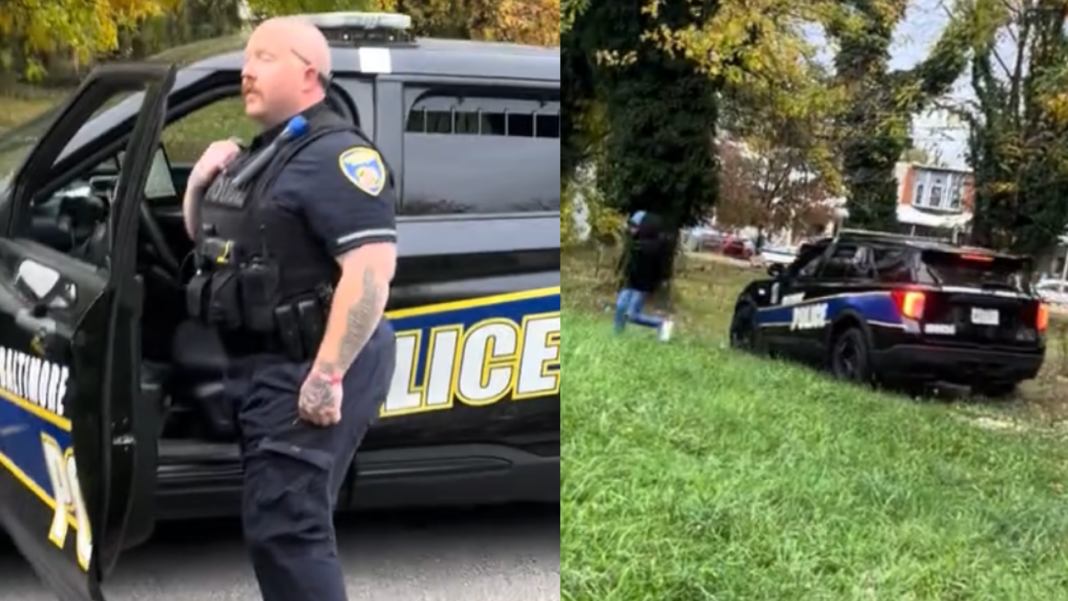Baltimore Police Officer Suspended After Disturbing Viral Video Incident
A recent incident involving a Baltimore City police officer has sparked outrage and calls for accountability after a viral video captured the officer driving his cruiser erratically and nearly running over a Black man. The unsettling footage has reignited discussions about police conduct and community safety in a city with a troubled history of police-municipality relations.
The Incident: A Disturbing Video
In the video that has circulated widely on social media platforms, an unidentified white police officer can be seen aggressively maneuvering his patrol vehicle off the main street, darting into an alley and onto a grassy field in a vacant lot located in the predominantly Black Park Heights neighborhood of West Baltimore. The context leading up to this reckless driving has yet to be disclosed, leaving many questions unanswered.
As the video unfolds, a bystander, who recorded the footage, confronts the officer, asking, “What’s your reason to stop him? You don’t even have no reason to stop him.” This exchange highlights the growing frustration within communities struggling to understand the rationale behind police actions, particularly in neighborhoods historically subjected to profiling and aggressive policing.
Response from City Officials
Baltimore Mayor Brandon Scott responded to the incident, expressing deep concern over the contents of the video. In an official statement, he confirmed that the officer in question has been suspended and that an investigation is underway. Scott emphasized the importance of accountability, stating, “This investigation will be thorough, in accordance with all laws and regulations.”
Police Commissioner Richard Worley echoed these sentiments in a separate statement. He characterized the officer’s conduct as “not only disturbing, but alarming,” remarking that it does not align with the values or standards expected of the Baltimore Police Department (BPD). Worley reiterated the department’s commitment to rebuilding trust with the community and ensuring that such behavior does not go unaddressed.
Historical Context: A Bumpy Road Towards Reform
The Baltimore Police Department has long grappled with issues surrounding police brutality and systemic racial discrimination. This latest incident comes against the backdrop of persistent protests and a federal investigation following the high-profile death of Freddie Gray, a 25-year-old Black man who died in police custody in 2015. His tragic death, attributed to severe injuries sustained while handcuffed in a police van, led to national outrage and demands for reform in policing practices.
A comprehensive investigation led by then-President Barack Obama’s Department of Justice identified a “pattern of unconstitutional and discriminatory policing” within the BPD. Officers were reportedly instructed to target Black individuals based on appearance—a practice that sparked widespread condemnation and highlighted the urgent need for reform.
Moving Forward: Calls for Change
The report released by the DOJ emphasized the need for better training, particularly in community policing practices, suggesting that such training should be tailored to personnel across all levels within the department. The overarching aim is to foster a culture that prioritizes community engagement rather than confrontation.
With this latest incident, community advocates are likely to intensify their calls for comprehensive reforms within the BPD, pushing for transparency, accountability, and significant changes in how officers are trained to interact with the communities they serve.
The Path Ahead
As the investigation unfolds and the community grapples with the implications of this incident, it is clear that the challenges facing the Baltimore Police Department are far from resolved. The outcome of this case could significantly impact public trust and the future relationship between law enforcement and the communities they are sworn to protect.
The citizens of Baltimore, particularly in neighborhoods that have historically faced scrutiny and discrimination, are watching closely. They hope that the measures put in place during this investigation contribute not only to accountability but also to the meaningful change that has been long overdue.



